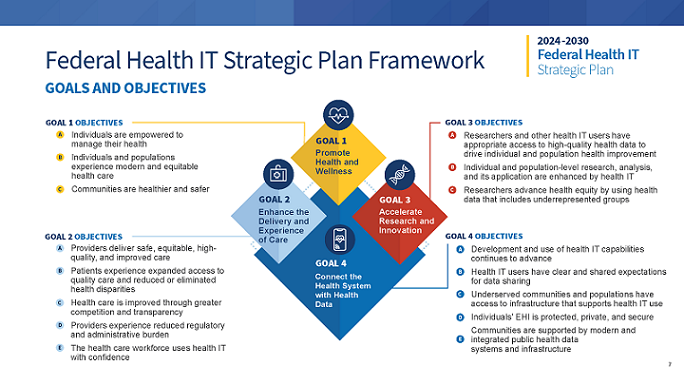 By Dustin Charles, Stephanie Lee, and Peter Karras, ONC
By Dustin Charles, Stephanie Lee, and Peter Karras, ONC
LinkedIn: Dustin Charles
LinkedIn: Peter Karras, MBA, PMP
LinkedIn: ASTP/ONC
The U.S. Department of Health and Human Services (HHS), through the Assistant Secretary for Technology Policy/Office of National Coordinator for Health Information Technology (hereafter ASTP), has released the final 2024-2030 Federal Health IT Strategic Plan (Plan).
The Plan is a tremendous step forward in the federal government’s continued focus on health IT and the opportunities it presents to improve care delivery and care coordination. The Plan builds on the preceding 2020-2025 Federal Health IT Strategic Plan to advance the access, exchange, and use of electronic health information (EHI) to improve health and wellness for individuals, populations, and communities, emphasizing a better, more equitable health care experience.
ASTP developed the Plan in collaboration with more than 25 federal partners and the final version is informed by public comments from a variety of organizations including health care systems, associations and specialty societies, EHR developers, patient advocates, and more.
What are the Plan’s Goals and Objectives?
The Plan is intentionally outcomes-focused, with the aim of improving access to EHI, creating a more equitable health care experience, and modernizing the nation’s public health infrastructure. The goals are divided into specific categories: Goals 1 through 3 target enhancements in the experiences and outcomes for health IT users, while Goal 4 focuses on the policies and technologies necessary to support those users.

Equity
The Plan continues the federal government’s commitment to using health IT as a tool to improve health equity across populations. Strategies in the Plan recognize the importance of representation in health data. The Plan also expresses the importance of access to health IT and seeks to expand health IT access opportunities by addressing the needs of under-resourced settings and health care provider types that have not received as much attention in the past.
Artificial Intelligence
With the rapid spread of artificial intelligence (AI), the Plan establishes a set of strategies for the federal government to expand awareness of how AI technologies can:
- be used by health IT users, including patients and caregivers;
- be deployed safely and responsibly; and
- help guard against algorithmic bias.
In particular, as AI plays a bigger role in health and in light of the Plan’s focus on equity, the data on which AI is trained needs to accurately reflect the populations for which it is designed. This means not only identifying and reducing biases but also doing so as part of the design of such AI and not waiting until the AI is put into processes and programs. These strategies will ground the federal government’s efforts to encourage an AI ecosystem that supports workflows, enables innovation, and generates trust through transparency.
Health Data Exchange
Health data exchange continues to be a priority for the federal government to ensure that quality data meets quality care. The Plan promotes the Trusted Exchange Framework and Common Agreement (TECFA) as a primary mechanism to progress secure, nationwide interoperability. The Plan emphasizes that data quality is essential to good exchange and presents strategies that address the federal government’s role in collaborating with standards development organizations, state and local governments, and health IT developers, to drive confidence in accurate, timely, and complete data for exchange, under the principle of getting the right data to the right place when it is needed.
Public Health
The Plan recognizes that public health touches all parts of the health care continuum, and that health IT is essential to maintaining effective public health awareness and response. Thus, public health is represented throughout each goal in the Plan, from community health to a knowledgeable public health workforce, to improved research, to building a robust public health technology infrastructure.
The COVID-19 pandemic further demonstrated the immense value that health IT plays in response to existing and emerging health hazards. The Plan emphasizes the importance of sharing health data throughout all levels of the health system, including among federal and non-federal actors, to ensure that not only are public health threats responded to quickly and efficiently, but potential adverse events can be identified and resolved before becoming emergencies.
Thank You
We thank commenters for their thoughtful feedback and contribution to the Plan’s vision to achieve a health IT-enabled future that uses EHI to engage individuals, deliver high-quality care, and improve health outcomes, while supporting end-user workflows, relieving burden, and promoting research and innovation.
Read the full Plan for additional detail on the federal government’s health IT vision.
This article was originally published on the Health IT Buzz and is syndicated here with permission.
